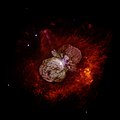Setshwantsho:Eta Carinae.jpg
Ponalo

Selekanyo sa tshedimoso ye: 600 × 599 pixels. Tse dingwe resolutions: 240 × 240 pixels | 480 × 480 pixels | 769 × 768 pixels | 1,025 × 1,024 pixels | 2,015 × 2,013 pixels.
Faele ya konokono (2,015 × 2,013 pixels, file size: 163 KB, MIME type: image/jpeg)
Segologolo sa setshwantsho
Tbetsa letsatsi/nako go bone faele jaaka ene e ntse ka nako eo.
| Letsatsi/Nako | Thumbnail | Dikarolwana | Modirisi | Comment | |
|---|---|---|---|---|---|
| ya jaanong | 11:41, 18 Sedimonthole 2017 |  | 2,015 × 2,013 (163 KB) | The NMI User | Reverted to version as of 14:14, 1 May 2008 (UTC) |
| 16:45, 13 Mopitlo 2017 |  | 3,000 × 2,998 (1.18 MB) | Leogorgon | larger file size | |
| 16:14, 1 Motsheganong 2008 |  | 2,015 × 2,013 (163 KB) | Vol de nuit | {{Information |Description=(NASA News Release) A huge, billowing pair of gas and dust clouds are captured in this stunning NASA Hubble Space Telescope image of the supermassive star Eta Carinae. Using a combination of image processing techniques (ditheri |
Tiriso ya setshwantsho
There are no pages that use this file.
Tiriso ya file ka karetso
Di wiki tse dingwe di dirisa setshwantsho se
- Dirisa mo da.wikipedia.org
- Dirisa mo en.wikipedia.org
- Star
- Eta Carinae
- Wikipedia:Selected anniversaries/March 11
- Wikipedia:Today's featured article/March 2017
- Wikipedia:WikiProject Wikipack Africa Content/Wikipedia:Showcase
- Wikipedia:WikiProject WikiFundi Content/Eta Carinae
- Wikipedia:Today's featured article/requests/Eta Carinae
- Wikipedia:Today's featured article/March 12, 2017
- Wikipedia:Main Page history/2017 March 12
- Wikipedia:WikiProject WikiFundi Content/Wikipedia:Showcase
- Wikipedia:Main Page history/2022 March 11
- Wikipedia:Main Page history/2022 March 11b
- Wikipedia:Main Page history/2023 March 11
- Wikipedia:Main Page history/2023 March 11b
- User:2003 LN6/sandbox/Eta Carinae variable
- List of luminous blue variable stars
- Dirisa mo en.wikiversity.org
- User:Marshallsumter/Radiation astronomy2/Visuals
- User:Marshallsumter/Radiation astronomy2/Violets
- Stars/Astronomy
- User:Marshallsumter/Radiation astronomy2/Violets/Quiz
- Stars/Sun/Astronomy/Quiz
- User:Marshallsumter/Radiation astronomy/Courses/Principles/Hourly 2
- User:Marshallsumter/Radiation astronomy/Courses/Principles/Final quiz
- Draft:Original research/Io/Quiz
- Titan/Quiz
- Stars/Solar systems/Quiz
- Moon/Quiz
- Earth/Quiz
- User:Marshallsumter/Radiation astronomy/Colors/Quiz
- Volcanoes/Io/Quiz
- Stars/Violets
- User:Marshallsumter/Radiation astronomy2/Stars
- Stars/Violets/Quiz
- Dirisa mo es.wikipedia.org
- Dirisa mo fr.wikipedia.org
- Dirisa mo hi.wikipedia.org
- Dirisa mo it.wikibooks.org
- Dirisa mo la.wikipedia.org
- Dirisa mo mk.wikipedia.org
- Dirisa mo ms.wikipedia.org
- Dirisa mo my.wikipedia.org
- Dirisa mo oc.wikipedia.org
- Dirisa mo ru.wikipedia.org
- Dirisa mo sk.wikipedia.org
- Dirisa mo sr.wikipedia.org
- Dirisa mo th.wikipedia.org
View more global usage of this file.

